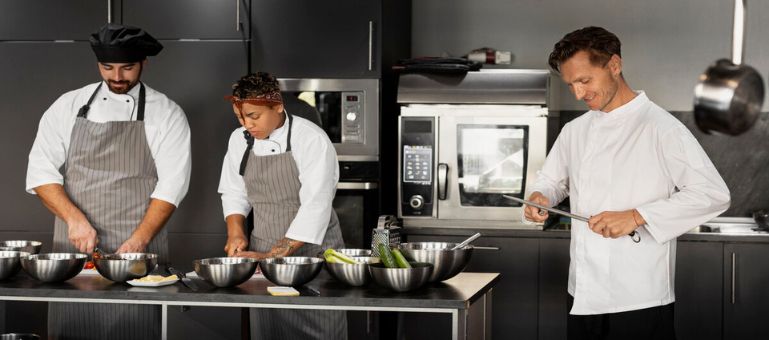The transformation from traditional culinary tools such as the Hearth to more cutting-edge innovations like Sous-vide cookers has been revolutionary. These kitchen equipment advancements can be attributed to continuous developments in technology.
The culinary technology shifts and the introduction of progressive kitchen tools have helped commercial kitchens become more compact, energy-efficient, and sustainable, along with helping them reduce wastage.
Chefs have also been able to experiment more with techniques and ingredients, fostering creativity.
It has been reported that the Commercial Cooking Equipment Manufacturing industry has grown at an annualized rate of 2.2% to $3.7 billion over the past five years. This reflects the continuing investment in commercial cooking equipment.
Let us now take you through the different stages that the kitchen equipment and commercial kitchens have been through.
The Foundations of Tradition

The Beginning
Let us trace the origins of commercial kitchen equipment. It begins with the Hearth, where humans learn to control fire and cook food. This was the first step towards using heat to experiment with ingredients leading to more culinary innovations.
With the advancement of our society, so did culinary craftsmanship. Clay clay pots and ceramic vessels emerged, used to make stews and broths.
The Transition to Metalwork
The transition from vintage kitchen implements such as clay to metal was an essential moment in the evolution of kitchen equipment. The Greeks and Romans crafted tools that could withstand higher temperatures, allowing for different cooking techniques, such as bronze cauldrons.
Medieval Culinary Implements
In the Middle Ages, kitchen equipment started to become more refined.
Earthenware and cast iron posts became more popular, and the open Hearth transitioned into enclosed fireplaces that provided separate compartments for baking, roasting, and simmering. Tools such as ladles, skillets, and griddles started to emerge.
Renaissance and the Birth of Culinary Specialization
The Renaissance period brought with it an emphasis on refinement and luxury. Copper pots and pans, which were known for their impressive heat conductivity, became a must-have. The emergence of sauces and complex dishes led to the invention of finer sieves, graters, and mortars.
The Age of Enlightenment and Culinary Innovation
The Age of Enlightenment saw a surge in culinary innovation and the development of more streamlined kitchen equipment. The focus shifted toward efficiency, hygiene, and precision.
The 18th century witnessed the rise of the cast iron skillet, a versatile tool that allowed for frying, searing, and baking.
The advent of the Industrial Revolution further transformed culinary tools, as mass production made equipment more accessible to a broader audience.
Classic Cast Iron Cookware and Beyond
The 19th and early 20th centuries marked the golden age of cast iron cookware. Skillets, Dutch ovens, and griddles became iconic symbols of culinary craftsmanship.
These durable pieces of equipment retained and distributed heat evenly, making them essential for various dishes.
As modernization continued, stainless steel and aluminum started to replace cast iron, leading to lighter and more efficient equipment.
The evolution of kitchen equipment reflects the innovation, creativity, and dedication of generations of chefs and cooks who have harnessed the power of fire and metal to create delicious and artful dishes.
Culinary Advancements and Innovations

Whether it was the introduction of gas stoves or the transition to using stainless steel cookware, the culinary technological shifts have been highly transformative, revolutionizing how we cook, prepare, and serve our food.
Let us delve into how this culinary progress has impacted commercial kitchen equipment:
The Era of Gas Stoves
The first culinary technological shift was when gas stoves emerged in the late 18th century, replacing the traditional open hearths and wood-burning stoves. These stoves allowed temperature regulation and consistent heat, making cooking more convenient and refined.
Stainless Steel Cookware: The Rise of Durability and Efficiency
Stainless steel cookware was introduced in the early 20th century, transforming culinary operations. This modern innovation improved the quality of cookware and the cleaning process by offering durability, excellent heat conductivity, and corrosion resistance.
The Appliance Revolution: Mechanized Marvels in Modern Kitchens
With the onset of the mid-20th century came the appliance revolution, which led to the mechanization of kitchen tools. Blenders, food processors, and electric mixers emerged, which helped reduce the time and effort that went into food preparation.
The microwave was introduced in the 1940s, helping with reheating and defrosting.
The Digital Age and Smart Kitchen Innovations
In the 21st century, technology was integrated into the culinary world. With smart kitchen appliances such as cooktops and digital cooking tools such as apps that provide access to all kinds of recipes, the culinary world was taken by storm, revolutionizing culinary operations with innovations
Sustainability and Energy Efficiency in Culinary Equipment
A growing emphasis has recently been on ensuring sustainable and energy-efficient commercial kitchen equipment. Innovations such as energy-efficient induction cooktops, convection ovens, and high-efficiency refrigerators have helped in this mission.
The Rise of Technological Integration
Technological advancements have drastically transformed the landscape of commercial kitchens. Over the years, technology integration, the adoption of electric appliances, automation, and bright kitchen devices have reshaped commercial kitchens.
Kitchen Tech Evolution
The evolution of kitchen technology started with electric appliances such as electric stoves, ovens, and grills that helped escape the previously manual and labor-intensive methods. These inventions helped chefs gain better cooking results, reducing the risk of potential accidents.
Automation Enhancement
The integration of automation in commercial kitchens was used for ingredient dispensing, mixing, and portioning. This sped up the food preparation process and improved quality while saving time and energy.
Precision Cooking
Precision cooking, often associated with sous-vide techniques, has become more accessible through technological integration. Sous-vide machines precisely control the water temperature to cook vacuum-sealed ingredients evenly.
This method ensures that meats are cooked to the perfect level of doneness, enhancing flavor and texture.
Smart Kitchen Devices
Smart kitchen devices such as refrigerators that can monitor inventory levels have helped minimize food waste and facilitate food preparation. These innovations have brought in a new era of culinary innovations.
Efficiency and Precision Advancements
The integration of technology, electric appliances, automation, and smart devices has led to substantial advancements in efficiency and precision within commercial kitchens:
- Time Efficiency: Automation helps in reducing the time required for repetitive tasks. This gives chefs more time for creative endeavors and recipe development.
- Consistency: Automated temperature control and precise cooking techniques ensure consistent results, eliminating the variability that comes with manual cooking methods.
- Resource Management: Smart kitchen devices help optimize ingredient usage, reduce waste, and minimize energy consumption through real-time monitoring and data analysis.
Sustainability and Eco-Friendly Solutions
In recent years, the culinary industry has undergone a significant shift towards sustainability, with commercial kitchens being at the forefront of embracing eco-friendly practices, incorporating energy-efficient appliances, utilizing eco-friendly materials, and implementing waste reduction strategies.
Green Kitchen Solutions
Modern commercial kitchens are now using a range of green solutions to reduce their ecological footprint. By using energy-efficient appliances such as Energy-efficient ovens, refrigerators, and cooking equipment, the overall carbon footprint of a kitchen can be reduced.
Sustainable Culinary Practices
Many commercial kitchens are now using eco-friendly materials in their construction, such as bamboo and reclaimed wood, along with adopting practices like composting food waste and recycling packaging materials to reduce waste and be more eco-friendly.
According to Chef Bryce Steba, over 10,000 kilos of food goes to waste in a single restaurant, one of the challenges commercial kitchens are trying to overcome.
Energy-Efficient Appliances
Energy-efficient cooking equipment, such as induction cooktops, convection ovens, and heat recovery systems, minimize energy wastage by using targeted heating methods and to enhance cooking precision and consistency.
Eco-Friendly Materials:
Commercial kitchens choose to use eco-friendly materials for utensils, cookware, and packaging.
Biodegradable and compostable materials, such as bamboo utensils and plant-based food containers, replace single-use plastics and reduce the environmental impact of disposable items.
Environmental Impact
Adopting sustainable practices in commercial kitchens by reducing energy consumption and waste generation has helped lower greenhouse gas emissions and decreased the depletion of natural resources.
These efforts align with broader global sustainability goals and set an example for other industries to follow.
Customization and Multifunctionality
There are different ways in which commercial kitchens can be customized, and multifunctionality can be promoted. Let us look at this in a little more detail:
Adaptive Culinary Solutions
With the evolution of culinary practices, there has been a growing demand for adaptive equipment for different cuisines and cooking styles. This has led to the identification of the importance of appliances that can be customized or tailored for specific requirements.
Space-Optimizing Appliances
Space optimization, for example, through combination ovens that can steam, bake, and grill, is crucial in both commercial and residential kitchens because they save space while maximizing efficiency.
Versatile Kitchen Tools
Instead of using separate tools for each task, multifunctional tools such as food processors that can be used for slicing, dicing, and grating have helped the modern kitchen be more versatile with reduced clutter and maximum efficiency.
Modular Designs
Modular kitchens provide flexibility and adaptability because units can be rearranged to fit the chef’s needs. This allows optimal usage of space and makes maintenance and upgrading kitchens a lot easier.
Optimizing Culinary Efficiency with Customized Equipment
The trend towards versatile and multifunctional kitchen equipment plays a crucial role in optimizing culinary efficiency by:
- Streamlining Workflows: Multifunctional appliances and modular designs help in forming a streamlined flow of tasks, which helps save time between cooking processes.
- Resource Management: Customizable settings and adaptable tools ensure precise resource utilization, minimizing energy consumption and ingredient waste.
- Reducing Clutter: Multifunctional tools minimize clutter in the kitchen, leading to cleaner and more organized cooking space.
Culinary Artistry and Creativity
From molecular gastronomy tools to precision sous-vide cookers that elevate flavor and texture, modern kitchen equipment plays a pivotal role in nurturing culinary creativity and exploration.
Innovative Culinary Implements
Modern kitchens use implements ranging from high-tech to traditional kitchen utensils. For example, molecular gastronomy tools like spherification kits and freeze-drying machines allow chefs to create visually stunning and captivating dishes that challenge traditional notions of food preparation.
Artistic Cooking Techniques
The increasingly innovative kitchen equipment gives rise to more artistic cooking techniques. For example, Nitrogen freezing and edible foams are artistic techniques that transform ingredients into unexpected forms and textures, taking customers on a visual and sensory journey.
Gastronomic Exploration
Modern kitchen equipment empowers chefs to explore new tastes and textures. A major example is Molecular gastronomy, which involves the manipulation of ingredients’ physical and chemical properties to create novel culinary experiences.
Molecular Gastronomy
Molecular gastronomy uses tools such as centrifuges, vacuum chambers, and precision scales to deconstruct and reassemble ingredients, resulting in surprising textures and flavor combinations.
Foams, gels, and liquid nitrogen are used to create dishes that go beyond expectations and engage all the senses.
Sous-Vide Cookers
The revolution in the way chefs approach precision has been transformed through Sous-vide cooking. Sous-vide immersion circulators maintain a controlled water temperature to cook ingredients evenly and precisely.
This technique preserves and enhances ingredients’ natural flavors, resulting in tender and flavourful food.
Pushing Culinary Boundaries
The availability of innovative kitchen equipment expanded the culinary toolkit and encouraged chefs to think outside the box. By experimenting with molecular gastronomy and cooking techniques like sous-vide, chefs can:
- Elevate Presentation: Through using innovative equipment, chefs can present their dishes by playing around with color and texture to create visual appeal.
- Surprise and Delight: Gastronomic exploration with innovative implements leads to unexpected flavor combinations and textures that surprise and delight diners.
- Culinary Storytelling: The use of such techniques enables chefs to craft narratives through food, engaging diners on a sensory and intellectual level.
The Role of Food and Beverage Trade Events

Food and beverage trade events play a pivotal role in the culinary industry by providing a platform for showcasing innovations, fostering collaboration and networking, and facilitating feedback and improvement.
These events serve as dynamic hubs where professionals, businesses, and enthusiasts converge to exchange ideas, discover new trends, and contribute to the growth and evolution of the culinary world.
Showcasing Innovations
Trade events serve multiple purposes: a launch pad for new ideas about food presentation and advancements in the industry, an opportunity to showcase the latest products, innovations, and techniques, and an excellent opportunity to network.
They provide a platform where attendees can witness firsthand the future of food and beverage, encouraging creativity.
Collaboration and Networking
Trade events host a wide variety of professionals from different sectors of the industry, such as suppliers, chefs, and distributors. Interacting and networking help in knowledge sharing, fostering new business relationships, and collaborative projects that contribute to culinary growth and innovation.
A study by Eliza Kitchen titled “What is the value of networking? An examination of trade show attendee outcomes.” reveals that attendees follow up with 20-30% of contacts received during a trade event once it is over.
This reveals that networking is important and can lead to the formation of strong contacts through which future collaborations can be planned.
Feedback and Improvement
Trade events provide a valuable platform for receiving direct feedback from industry peers, customers, and critics. Demonstrating products, offering tastings, and engaging in discussions enable businesses to gather insights that can guide refinement and improvement.
This process helps companies tailor their offerings to meet consumers’ evolving needs and preferences, driving continuous innovation and quality enhancement.
The Future of Commercial Kitchens
The future of commercial kitchens holds exciting possibilities as emerging technologies like AI, robotics, and sustainability initiatives reshape the culinary landscape.
Culinary Tech Visions
Artificial intelligence can help in analyzing data, which is then used to predict trends and personalize menus based on customer preferences. Moreover, AI-powered sensors can monitor cooking processes, streamline operations, and empower chefs to create innovative culinary experiences.
Robotic Kitchen Revolution
The operations of commercial kitchens have been revolutionized through the integration of robotics. Robotic arms can perform intricate tasks, such as chopping, sautéing, and plating, with precision and consistency.
This robotic assistance allows chefs to focus on creative aspects of cooking, and robotic systems can collaborate seamlessly with AI, enhancing coordination and efficiency in the kitchen.
Advanced Kitchen Solutions
Future kitchens will likely use AI-powered smart appliances to help maintain quality.
Robotics will help rapid food preparation and reduce human error. Moreover, sustainable practices such as composting and energy-efficient equipment will be seamlessly integrated.
Redefining Kitchen Operations
The use of AI, robotics, and sustainability initiatives can be used to redefine commercial kitchen operations in several ways:
- Enhanced Efficiency: AI-driven analytics and robotic assistance can streamline workflows, leading to smoother operations and quicker service.
- Precision and Consistency: Robotics and AI can ensure precise cooking techniques and consistent results, elevating the quality of dishes.
- Creative Exploration: Automation of routine tasks can free up chefs to experiment with innovative recipes and culinary concepts.
Conclusion
In summary, the commercial kitchen transformation can be attributed to the dynamic equipment shift, which first started with the simple Hearth being replaced by metal pots and, eventually, in the 21st century, where multi-purpose equipment and digitized solutions have been essentials.
It is important for commercial kitchens and chefs to celebrate the evolution of culinary equipment because it has brought with it so many advantages, like the need for less space, increased efficiency, reduced waste, and the ability to explore and experiment with food.
It is, however, important to remember and appreciate traditions and the beginning of the journey in order to truly appreciate the transformations that have taken place in the art of cooking.













